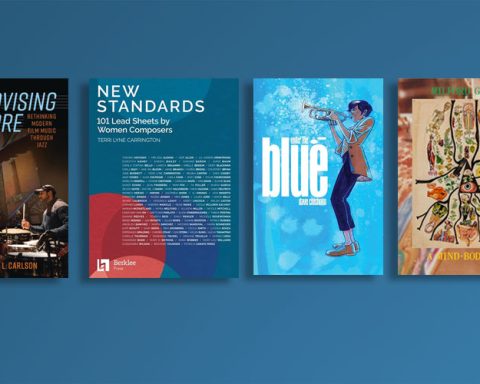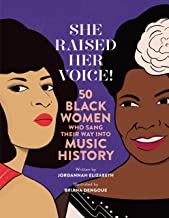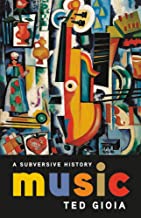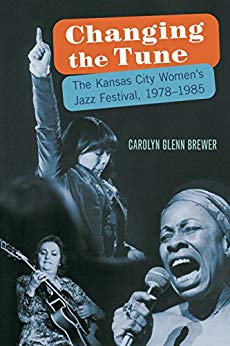In James Joyce’s Ulysses there is a meandering conversation about Shakespeare’s art, turning at one point to speculations about the man himself. An interlocutor “impatiently” interrupts: “But this prying into the family life of a great man. . . . I mean, we have the plays. I mean, when we read the poetry of King Lear what is it to us how the poet lived?”
Well, interest in how the poet — or the novelist, playwright, critic, painter, actor, musician — lived drives a part of the publishing industry and the media and satisfies the curiosity of many readers, listeners and viewers. It’s not going to go away, that’s for sure. Nor should it, pace Joyce’s objector. Knowledge about the artist helps us understand his and her art.
Bob Dylan’s recording career has spanned a half-century, drawing from folk music (American, English, Scottish, and Irish), blues, country, gospel, rock and roll and rockabilly. It has also included elements of jazz and the Great American Songbook.
He performs on guitar, keyboards and harmonica and is supported by a changing band personnel. He has toured constantly for decades on what has come to be known as the Never Ending Tour. His accomplishments as a recording artist and performer have constituted a great part of his career but his songwriting is considered his greatest artistic contribution. His lyrics, initially inspired by Woody Guthrie, Robert Johnson and Hank Williams and defying the conventions of pop music, have incorporated political, social, philosophical and literary themes, in the process personalizing musical genres and acquiring an immense listenership, not just in the counterculture, as in the beginning of his career, but in the wider public. He is indeed a superstar and an American artistic icon.

Wikipedia says that Dylan has sold more than 100 million records and received a Grammy, Golden Globe and Academy Award and been inducted into the Rock and Roll Hall of Fame, Minnesota Music Hall of Fame, Nashville Songwriters Hall of Fame and Songwriters Hall of Fame. His Pulitzer Prize in 2008 was for “his profound impact on popular music and American culture, marked by lyrical compositions of extraordinary poetic power.” In 2012 he was awarded the Presidential Medal of Freedom from Barack Obama. Dylan has published Tarantula, a work of prose poetry; Chronicles: Volume One, the first part of his memoirs; several books of his song lyrics, and six books of his art. A Wikipedia discography for Dylan lists 36 studio albums, 58 singles, 11 live albums, 11 albums comprising The Bootleg Series and many compilation albums. After searching on the Internet, I estimate that at least 50 books have been published about Bob Dylan.
In his Preface to his volume of photographs, Bob Dylan: NYC 1961-1964, Ted Russell says that he has “often thought of [his] life as a series of Walter Mitty-like fantasies [that] sometimes became real because of lucky accidents,” citing “the chain of events that led me to Bob Dylan [as] a prime example.” He recounts how his photojournalistic career wound its circuitous way through freelancing for record label publicity departments to an assignment from Columbia Records to shoot “a new and upcoming young folk singer” who “presented the persona of an itinerant hobo-like character in the tradition of Woody Guthrie, riding freight trains in old blue jeans, wearing a funny cap, and singing and writing folk songs as he strummed his guitar.”
A stranger to the folk music scene, Russell was “something of a jazz aficionado, collecting old Charlie Parker records” and hanging out at the Five Spot Café and the Half Note to hear Gerry Mulligan, Thelonious Monk and Tony Scott. As an enticement to check out Dylan, he was provided a copy of New York Times music critic Robert Shelton’s recent rave review of Dylan performing. So Russell made his way over to Gerde’s Folk City in Greenwich Village in November 1961, following up a couple of days later for an additional shoot of Dylan in his walk-up apartment at 161 West 4th Street. A later assignment again providing him access to Dylan, Russell caught him with James 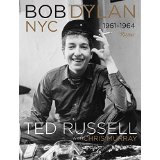 Baldwin, and prints from this shoot are included in the volume. There are also several images from Russell’s wide-ranging photojournalistic career, for example, two delightful images of Marilyn Monroe as she arrived (her plane is in the background) in Korea in 1954. Broadly smiling and resplendent in her beauty, infectious sex appeal, and that “certain indefinable magic” (director Billy Wilder’s assessment), she is surrounded by some of the troops whom she came to entertain.
Baldwin, and prints from this shoot are included in the volume. There are also several images from Russell’s wide-ranging photojournalistic career, for example, two delightful images of Marilyn Monroe as she arrived (her plane is in the background) in Korea in 1954. Broadly smiling and resplendent in her beauty, infectious sex appeal, and that “certain indefinable magic” (director Billy Wilder’s assessment), she is surrounded by some of the troops whom she came to entertain.
A number of frames are of Dylan at mic in the club, guitar and/or voice and harmonica in action. The 20-year-old newcomer to the New York scene is quite evidently enjoying himself. Introducing the shoot in the apartment, Russell told Dylan and his then girlfriend Suze Rotolo (who in 2008 would publish her A Freewheelin’ Time: A Memoir of Greenwich Village in the Sixties and who died in 2011, age 67) to carry on as though he weren’t there and, judging by the book’s intimate and relaxed photos, they did just that. Here is the couple on a mattress, she sitting with back against the wall dragging on a cigarette, he lying supine with head on her lap, guitar athwart his upper body, staring at the ceiling. This and other shots of the young pair clearly show them as being in delighted love. Here is Dylan strumming his guitar, blowing on harmonica, doing both together; at table typing; carrying a box into the apartment (it seems to have been moving day, Russell observes); looking reflectively away from the camera and smiling at it. The black-and-white images are sharp, the figures in them all but springing off the pages at you. Russell is adept at catching “the moment of truth.” It is a rare and moving experience and a rewarding revelation to again and again view the volume’s photographs, gaining with each viewing a deeper feeling for and understanding of the fledgling artist Dylan was back in that day.
Chris Murray’s Introduction to Bob Dylan: NYC 1961-1964 provides a detailed account of Ted Russell’s extraordinary career and, as he fittingly says at its conclusion, the collection “is a unique contribution [that] documents Dylan’s very first years as a musical genius in Greenwich Village. Bob Dylan, a bohemian poet, would become, according to many, the most original and influential songwriter of our time, and we are enriched by this portrait of the artist as a young man.”
Donovan offers, as the volume’s Foreword, a two page “unreleased ballad,” giving expressing to his conviction that he and Dylan “share the same beginnings and the same studio smarts as teens listening to ’50s Rock & Roll” and that he “know[s] what is happening in Ted’s photographs for [he] lived it too.” It is a welcome and moving tribute to his and many others’ mentor and inspiration.
The most recent biography of Dylan is Ian Bell’s excellent Time Out of Mind: The Lives of Bob Dylan, the second volume follow-up to his 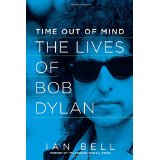 Once Upon a Time: The Lives of Bob Dylan. It is both a biography that leaves no stone unturned and a critical study that examines his work, album-by-album and concert-by-concert, in detail. I recommend it to anyone seeking insight into the poetry and music of this great American artist. I haven’t so enjoyed reading about the life of a pop musician since reading Daniel Cooper’s biography of Lefty Frizzell, Peter Guralnick’s of Elvis Presley, and Mark Zwonitzer’s and Charles Hirshberg’s of the Carter Family. Of Ian Bell’s magisterial two-volume Bob Dylan biography, author Geoff Dyer enthuses, “I had been gripped by Bell’s first volume . . . [and] the second volume . . . has the special ‘this is where I came in’ attraction of history one has actually experienced.” Neither volume has photos, both have source notes, bibliographies, and indices. As a supplement to Ted Russell’s images in Bob Dylan: NYC 1961-1964, I especially suggest reading the first volume of Bell’s magisterial set.
Once Upon a Time: The Lives of Bob Dylan. It is both a biography that leaves no stone unturned and a critical study that examines his work, album-by-album and concert-by-concert, in detail. I recommend it to anyone seeking insight into the poetry and music of this great American artist. I haven’t so enjoyed reading about the life of a pop musician since reading Daniel Cooper’s biography of Lefty Frizzell, Peter Guralnick’s of Elvis Presley, and Mark Zwonitzer’s and Charles Hirshberg’s of the Carter Family. Of Ian Bell’s magisterial two-volume Bob Dylan biography, author Geoff Dyer enthuses, “I had been gripped by Bell’s first volume . . . [and] the second volume . . . has the special ‘this is where I came in’ attraction of history one has actually experienced.” Neither volume has photos, both have source notes, bibliographies, and indices. As a supplement to Ted Russell’s images in Bob Dylan: NYC 1961-1964, I especially suggest reading the first volume of Bell’s magisterial set.
Elijah Wald, who has written a number of ground-breaking books on the blues, folk music and other genres, covers in his Dylan Goes Electric!: Newport, Seeger, Dylan, and the Night That Split the Sixties what Ian Bell reasonably devotes only several chapters to in his first volume. Wald explores the cultural, political and historical context of the seminal event cited in the book’s title and provides new insights into the artistic evolution of one of the major performing artists and songwriters of our time. He probes Dylan’s deep feeling for the blues, his vexed relationship to the reigning folk music establishment and the many ways in which he reshaped pop music. It is an absorbing account of how, on July 25, 1965, Dylan, supported by an electric band, mounted the stage of the Newport Folk Festival and blasted forth with his new hit recording “Like a Rolling Stone.” The audience was full of the era’s folk music purists and political activists who, for a couple of years, had considered the acoustic Dylan their prophet, and they reacted with horror, booing him. It was indeed a musical shot heard round the world, announcing Dylan’s declaration of his artistic independence. It all but signaled the end of the folk revival and established rock music as the preferred genre of his generation. As Wald says in his Acknowledgements, the book “explores the world [he himself] grew up in” and he has achieved, impressively, what will long be considered the definitive account of this period of Dylan’s career. He “tried whenever possible to go back to primary sources . . . and was fortunate to have fuller access to some key sources than the myriad previous researchers who have covered much of this ground.” The volume has notes, a bibliography, index and some splendid photographs of Dylan and his musical associates.
blasted forth with his new hit recording “Like a Rolling Stone.” The audience was full of the era’s folk music purists and political activists who, for a couple of years, had considered the acoustic Dylan their prophet, and they reacted with horror, booing him. It was indeed a musical shot heard round the world, announcing Dylan’s declaration of his artistic independence. It all but signaled the end of the folk revival and established rock music as the preferred genre of his generation. As Wald says in his Acknowledgements, the book “explores the world [he himself] grew up in” and he has achieved, impressively, what will long be considered the definitive account of this period of Dylan’s career. He “tried whenever possible to go back to primary sources . . . and was fortunate to have fuller access to some key sources than the myriad previous researchers who have covered much of this ground.” The volume has notes, a bibliography, index and some splendid photographs of Dylan and his musical associates.
“The government’s not going to create jobs,” Bob Dylan said in the February/March 2015 issue of AARP:The Magazine in his first interview in nearly three years. “It doesn’t have to. People have to create jobs, and these big billionaires are the ones who can do it.” He sees inner cities festering with crime and people “turning to alcohol and drugs. They could all have work created for them by all these hotshot billionaires. For sure, that would create a lot of happiness. Now, I’m not saying they have to — I’m not talking about communism — but what do they do with their money?” It doesn’t seem that Bob Dylan has put aside his feelings for the common folk, does it?
Bob Dylan: NYC 1961-1964 by Ted Russell (Photographs and Preface), Chris Murray (Introduction), Donovan (Foreword) Rizzoli Publications, 144 pages, $35 hardcover
Time Out of Mind: The Lives of Bob Dylan by Ian Bell, Pegasus Books, 576 pages, $35 hardcover
Once Upon a Time: The Lives of Bob Dylan by Ian Bell, Pegasus Books, 590 pages, $17.95 paperback
Dylan Goes Electric!: Newport, Seeger, Dylan, and the Night That Split the Sixties by Elijah Wald, Dey Street Books/Harper Collins, 354 pages, $26.99 hardcover
W. Royal Stokes was the 2014 recipient of the Jazz Journalists Association’s Lifetime Achievement in Jazz Journalism Award. He is the author of Growing Up With Jazz: Twenty-Four Musicians Talk About Their Lives and Careers and other books on jazz. Volume 1 of his trilogy of novels Backwards Over, Rufus Has Been on the Lam, was published in June.

